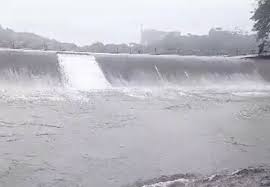After significant rains, Mumbai’s Vihar and Tansa Lakes overflow
The main supplies of drinkable water for Mumbai, the Tansa and Vihar lakes, began overflowing on Wednesday as a result of the recent severe rains, according to the Brihanmumbai Municipal Corporation (BMC).
The Vihar, Tansa, and Tulsi lakes have overflowed so far out of the seven reservoirs that provide water to Mumbai. According to the BMC, the Tansa lake in the neighboring Thane district flooded around 4.35 am on Wednesday, while the Vihar lake in Mumbai’s Sanjay Gandhi National Park spilled at 12.48 am.
Tansa Lake, one of the seven lakes that provide water to Mumbai residents, began overflowing today (July 26, 2023) at 4:35 AM, according to a tweet from the municipal organization. On July 20, when a lot of rain fell in the city and environs, the Tulsi Lake flooded.
The seven reservoirs in the Mumbai, Thane, and Nashik districts—Bhatsa, Upper Vaitarna, Middle Vaitarna, Tansa, Modak Sagar, Vihar, and Tulsi—provide 3,800 MLD (millions of litres per day) of water to Mumbai.
Notably, the BMC enforced a 10% water reduction here starting on July 1 after Mumbai’s water supply lakes’ levels dropped as a result of insufficient rain at the time in their catchment districts. The Powai lake in Mumbai also began overflowing earlier this month, but according to BMC authorities, its water is not utilized for drinking.
According to a press statement from the Thane district administration, a discharge of 1,100 cusecs (cubic feet per second) of water has begun from the reservoir as a result of the Tansa lake overflowing.
It said that the water storage levels in the Middle Vaitarna reservoir were 69.95%, 99.91% in Tansa, 87.69% in Modak Sagar, and 100% in the Vihar and Tulsi lakes. According to the announcement, the water storage in the Barvi dam in Thane district was 80.76%, compared to 61.72% in the Bhatsa dam.
Water storage in the Kavdas and Wandri reservoirs, as well as the Dhamni dam, was 100% in the Palghar district. Additionally, the report said that the water storage level in Nashik’s Upper Vaitarna reservoir was 52.14 percent.







